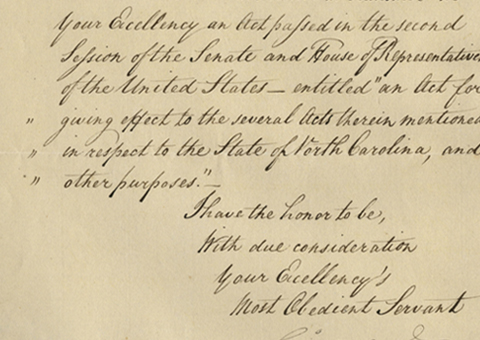An Extraordinary Rarity: Hymnal of John Clem, the Civil War’s Youngest Soldier, Signed by Him As a Child During the War



Obtained through his descendants and never previously offered for sale.
Born in 1851 as John Joseph Klem, he ran away from home at age 9 after his mother died. In May 1861, when President Lincoln issued the call for volunteers to serve in the Union Army for a three year term, one of those who tried to answer was Klem. Not yet...
Born in 1851 as John Joseph Klem, he ran away from home at age 9 after his mother died. In May 1861, when President Lincoln issued the call for volunteers to serve in the Union Army for a three year term, one of those who tried to answer was Klem. Not yet 10 years old, his service was refused by the newly formed 3rd Ohio Infantry because of his age and small size. In 1862 he tried to join the 22nd Michigan Infantry, a fighting unit which sustained 400 fatalities during the war. It initially refused him, but his persistence won over the unit’s officers, and they agreed to let him follow the regiment as a mascot and drummer boy. Officers chipped in to pay him the regular soldier’s wage of $13 a month, and finally allowed him to formally enlist in 1863. On march with the troops at age 11, he is considered the youngest soldier of the Civil War.
Klem very soon changed his name to John Clem and in time to John Lincoln Clem, which is how he is remembered today. At the Battle of Chickamauga, he rode an artillery caisson to the front and wielded a musket trimmed to his size. In his regiment’s defense of Horseshoe Ridge on the afternoon of September 20, Confederate forces surrounded the unit. A Confederate colonel spotted Clem and shouted either “I think the best thing a mite of a chap like you can do is drop that gun,” or called him a “damned little Yankee devil,” according to various sources. Rather than surrender, Clem shot the colonel and successfully made his way back to Union lines. For his actions, Clem was promoted to sergeant, the youngest soldier ever to become a noncommissioned officer in the U.S. Army, and became known as the “Drummer Boy of Chickamauga.”
In October 1863, Clem was captured in Georgia by Confederate cavalry while detailed as a train guard. The Confederate soldiers confiscated his uniform which reportedly upset him terribly—including his cap which had three bullet holes in it. He was exchanged a short time later, but the Confederate newspapers used his age and celebrity status to show “what sore straits the Yankees are driven, when they have to send their babes out to fight us.”
Clem participated with the Army of the Cumberland in many other battles as a mounted orderly (including Perryville, Murfreesboro, Kennesaw Mountain and Atlanta, where he was wounded twice). He was discharged from the Army in September 1864 at age 13. He sought to rejoin the military in 1870, and President Grant appointed him a 2nd lieutenant in the U.S. Army. Clem enjoyed a successful second military career, rising to the rank of colonel and assistant quartermaster general by 1906. He retired on the eve of U.S. entry into World War I with the rank of major general, the last Civil War veteran to actively serve in the U.S. Army. Clem then moved to San Antonio, Texas, and died in 1937. He is buried at Arlington National Cemetery. His family remained in San Antonio, and his daughter was active in preservation of Fort Sam Houston there.
“The Soldier’s Hymn Book”, which was published in 1861 by the Chicago Young Men’s Christian Association, was a small book given out to soldiers, and designed to be light and easily carried in their backpacks. On its first page is printed the United States flag, and the contents contain the Lord’s Prayer, hymns like “Nearer My God to Thee”, other songs like “Home Sweet Home”, and psalms like “The Lord Is My Shepherd.”
Clem had a copy of this book, and carried it with him during the war. In the front endpaper, he has signed his name and proudly identified himself with his unit, the 22nd Michigan, writing “John Clem, Co C, 22d.” There are other signatures of Clem both at front and back, which appear to be in another handwriting, perhaps his daughter’s. The names of a few of his soldier colleagues are written in as well. The book, along with other memorabilia, descended to his daughter. She gave it to a friend who was involved in preserving something close to her heart – Fort Sam Houston. We obtained it from the estate of that friend.
We have never before had (or even seen) an autograph of Clem as a child on the market, no less his signed hymnal as a member of the 22nd Michigan Infantry, that he carried through the Civil War. A truly extraordinary item, and never previously offered for sale.

Frame, Display, Preserve
Each frame is custom constructed, using only proper museum archival materials. This includes:The finest frames, tailored to match the document you have chosen. These can period style, antiqued, gilded, wood, etc. Fabric mats, including silk and satin, as well as museum mat board with hand painted bevels. Attachment of the document to the matting to ensure its protection. This "hinging" is done according to archival standards. Protective "glass," or Tru Vue Optium Acrylic glazing, which is shatter resistant, 99% UV protective, and anti-reflective. You benefit from our decades of experience in designing and creating beautiful, compelling, and protective framed historical documents.
Learn more about our Framing Services










































































































